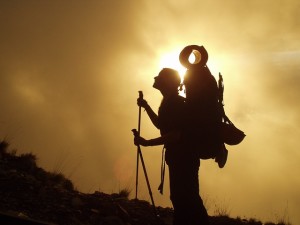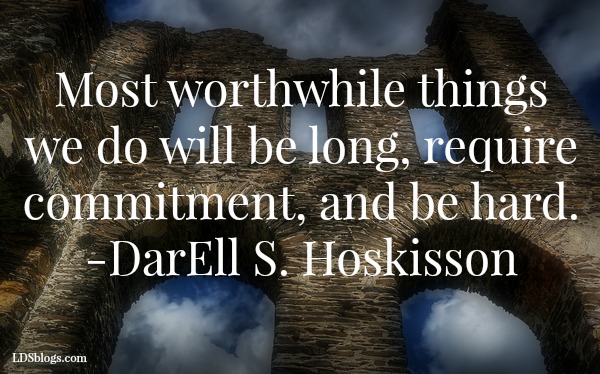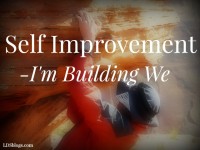Is the problem you are trying to solve actually the problem?
The question stares up at me from my desk. It is such a useful question. I love to solve problems, clearing the way for freedom and progress. I have to remember to ask myself that question because so often I find myself working hard to overcome symptoms and not addressing core causes.
For example, I spent years trying to conquer fear. I admire courage and want to be that kind of fearless person. For some fears, facing them is very, very effective. By gradually and safely exposing yourself to things you fear, you can overcome many. For example, you can look at a picture of a snake until you are no longer repulsed by it. Then, you could touch the picture. Then, you could see a snake through a window that is in a cage in another room. You repeat each step until you are calm and feel no stress before you try to move a little closer. This works for some types of fear.
 But, not understanding fear, I thought that I could overcome it altogether. I came to realize that losing all fear is both unrealistic and potentially dangerous. Fighting fear caught me in a mental feedback loop that actually caused more fear. It was an over-reaction and a trap. My problem was not that I felt fear. My problem was not being unable to prevent or overcome it. Trying to solve the wrong problem was actually creating this problem. Instead of working to become fearless, I needed to learn to live well with fear. So, the actual problem was not what I supposed.
But, not understanding fear, I thought that I could overcome it altogether. I came to realize that losing all fear is both unrealistic and potentially dangerous. Fighting fear caught me in a mental feedback loop that actually caused more fear. It was an over-reaction and a trap. My problem was not that I felt fear. My problem was not being unable to prevent or overcome it. Trying to solve the wrong problem was actually creating this problem. Instead of working to become fearless, I needed to learn to live well with fear. So, the actual problem was not what I supposed.
Correctly defining the problem is at least half of the solution.
I believe that correctly defining the problem is often the most critical step in finding the right solution.
To visualize and identity types of problems, I like to ask myself, is this a mountain, a boulder, a cliff face, or a guard rail?
Many years ago we had a family reunion at one of the national parks in southern Utah. I found myself with my young children climbing a narrow path of hard red rock. On either side of us was a sheer cliff. The cliff on the right formed an imposing, solid wall. The cliff on the left dropped off vertically into the chasm below. The path itself was narrow and steep.
 I watched my children navigate the trail. My son who was adventurous and apparently fearless liked to walk along the border of rocks that lined the left side of the trail. He wanted to balance on the rocks and liked to look down the canyon. I, knowing that often the rocks on the edge may not be that secure was in a constant panic that one would give way and that would be the end of him. I was constantly pulling him back toward the center of the trail.
I watched my children navigate the trail. My son who was adventurous and apparently fearless liked to walk along the border of rocks that lined the left side of the trail. He wanted to balance on the rocks and liked to look down the canyon. I, knowing that often the rocks on the edge may not be that secure was in a constant panic that one would give way and that would be the end of him. I was constantly pulling him back toward the center of the trail.
My daughter, on the other hand, saw my fear and, unlike my son, took to heart every word of my caution. She hugged the right side of the trail and had a hard time enjoying the experience at all. If I hadn’t been so busy trying to keep her brother alive, I would have gently encouraged her to come a step farther away from the wall. There was no danger of falling and the view was much better, just one step closer to the center.
I use this experience to visualize the different challenges that come my way.
What is the problem?
When I find a problem or a limit in my way, I have to first figure out what it is in order to deal with it. It is so easy to confuse things.
The first, most common type of problem I think, is just the challenge of trying. It is like climbing a mountain, working against gravity. We are always going uphill if we are working to improve. Trying something new is like climbing a steep path. It is hard just because it is new.
Ralph Waldo Emerson reminds us, “That which we persist in doing becomes easier to do, not that the nature of the thing has changed but that our power to do has increased.”
Most worthwhile things we do will be long, require commitment and be hard. In his book called The Dip, Seth Godin points out that if it isn’t worth the struggle, it might be best to not start on the path. But once we commit to a path, we need to stick with it or all the effort and potential rewards are lost if we quit when it gets hard. Because it will get hard. We need to expect that good, worthwhile things will be difficult, and this is normal.
If it is a mountain, I have to just keep climbing. I can rest or adjust the pace if I need to, but the path lies clearly ahead, and I need to keep moving forward.
 The second type of problem is what I call a boulder. It is something in the way of the clearly marked path. These problems are like rocks that fell down from above and block your way. They are not a true limit like the cliff wall or the chasm drop off, but they stop or slow progress. They have to be addressed.
The second type of problem is what I call a boulder. It is something in the way of the clearly marked path. These problems are like rocks that fell down from above and block your way. They are not a true limit like the cliff wall or the chasm drop off, but they stop or slow progress. They have to be addressed.
If the problem is surmountable, it is a boulder. Creativity wins here. What will work? Can I go over it? Can I go under it? Can I tunnel through it? Can I move it alone? Can I get help to move it out of the way?
A lot of times we won’t know if it is surmountable, conquerable at all until we have patiently tried and tried again, received help from others, and if it truly will not be solved, it could be one of three things:
It could be someone else’s problem
Over and over again I’ve learned that I can not solve a problem for others. I could help them get their car out of the mud, but if they continue to drive it right in again, I’ll eventually quit my pointless “helping.”
If, through all my efforts, I’ve had no impact on the problem, it could be that the problem is not mine. Like the sword in the stone, a problem will not resolve itself when I’m butting into someone else’s business, even accidentally.
It could be someone else is the problem
If the “boulder” is a person, often they can feel like the enemy. Working at cross purposes is so common, so frustrating, and so difficult. Many of my articles are about dealing well with people that seem like boulders. I wrote a personal blog called “Trying to work with a boulder” on this same subject https://personalabridgements.wordpress.com/tag/captain-jack-sparrow/.
I know that if I am working with someone who is the problem, then I have lost sight of the true problem. As long as I keep fighting someone, progress will be delayed or stopped altogether. I know that people feel like problems, but ultimately, the person putting on the brakes may hold the key. It is hard to get the key from an enemy.
I need to redefine the problem, again.
It could be a wall
 If it is a true limit, which might be something only time will tell, acceptance and redirection are the only paths left open to me. There are real limits in life. Many are not true limits but may truly not be worth the sacrifice or effort. Although theoretically I could try to scale the rock face of that canyon or follow the path–in my case, walking up the path was worth the safety and relative ease it provided. Not a realistic or reasonable choice, scaling the cliff was not really ever an option for me.
If it is a true limit, which might be something only time will tell, acceptance and redirection are the only paths left open to me. There are real limits in life. Many are not true limits but may truly not be worth the sacrifice or effort. Although theoretically I could try to scale the rock face of that canyon or follow the path–in my case, walking up the path was worth the safety and relative ease it provided. Not a realistic or reasonable choice, scaling the cliff was not really ever an option for me.
It could be a guard rail
If we mistakenly judge a guard rail as a boulder, using all our force and creativity to break it down, before we are aware, we could end up alone and broken at the bottom of the canyon. It is easy to want to break down limits, explore possibility, stop jumping through hoops and get there faster. But cutting corners and disregarding the limits of health, our teams and safety, although it feels free, usually exacts a heavy toll. Free falling feels free. It is just headed in the entirely wrong direction.
I love freedom, but I have to remember that that is why I love good guardrails. True freedom helps us prevent those accidental leaps into the chasm. As much as I love pushing limits, Christopher Marlowe reminds me of the plunge I hope to never take,
“Hell hath no limits.”
This canyon experience has become the picture that helps me evaluate what I’m doing. There are only two instances where persistence is a virtue…moving up the mountain and moving boulders in the way. If it is anything else, I’m wasting my time.
I can’t blindly fight all rules in a misguided effort to be free or be so afraid of the drop off that I cling to the cliff for safety. To do either is a distraction at best and a tragic death at worst.
May the problem you are trying to overcome be the actual problem.
Namaste,
DarEll S. Hoskisson
About DarEll Hoskisson
DarEll S. Hoskisson loves to do hard things, but not too hard. She shares her own challenges, goals and experiences as she guides you into a realistic path of self-reflection and self-improvement. She shares tips on how to find, know and trust yourself so you can decide if other’s suggestions are right for you.
DarEll has the world a little upside down—where work is play and play is work. She actually thinks other people’s problems are fun to try to solve and lights up with a personal challenge. She loves people, harmony, and excellence. She also loves useful things like tools and ideas that make work faster, easier and more fun.
DarEll married in 1993 and graduated from BYU (1995) with a bachelor’s degree in English and Secondary Education. Since then she was adopted by 5 children and has worked with many non-profits. She is currently a certified personal trainer and group fitness instructor—leading pilates and yoga at her local YMCA.
DarEll lives in Florida where she enjoys her family, nature, her work, and encouraging people to live well.
She periodically posts her poems, what she is learning, and service opportunities on her personal blogs:
https://personalabridgements.wordpress.com and https://darellhoskisson.wordpress.com
Twitter •








I think we all have problems with this at times – identifying what the problem really is.
Then, learning, as you put it, “to live well” with the things we cannot change or are not our problem is also a challenge. It is hard.
Even when we are working hard to move forward and don’t have some of these other issues slowing us down, it is still hard to keep moving forward –
I think having realistic expectations helps with that – the understanding as you so well said that, “most worthwhile things we do will be long, require commitment, and be hard”.
I will use your analagy to help me figure out – is this the mountain, a boulder, a wall, or a guard rail? It will help me know how to better handle the challenges that come my way.